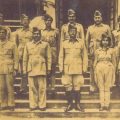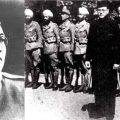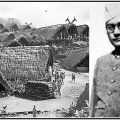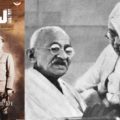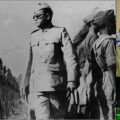Netaji Bose’s Secret Service and INA Connection with Submarines
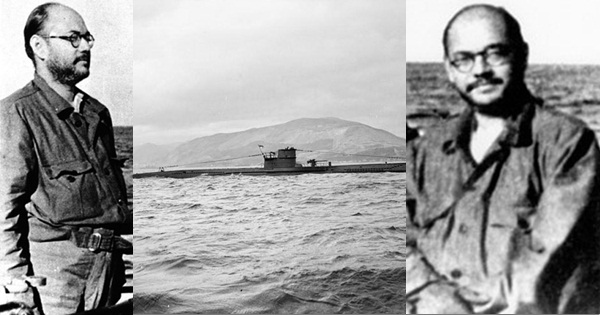
INA and its exploits on Land are well known. In fact, the Indo Japanese combined troupes under the unified command of Netaji Subhas Chandra Bose and Lt Gen Mataguchi’s 15th Army crossed over to the land of their destination. Even in the eyes of one time adversary, the British MI5 agent Huge Toye, there can be little doubt that the INA, not in the unhappy career of the battlefield, but in its thunderous disintegration hastened the end of British rule in India.
In this treatise, let me dwell on the Indian National Army’s tryst with water and particular reference to a lesser-known maritime dimensions: Submarines.
Broadly we can concern ourselves with three episodes related to submarine ventures during the WW II. Of course Netaji’s epic journey from Kiel in Germany to Japanese controlled Sabang on 8th Feb 1943 takes the cake. However, submarines were also used extensively for deployment of INA’s clandestine and subversive activities, popularly known as “Netaji’s Secret Service”. The third, a relatively unknown facet, touches upon interception of a ship carrying the INA cadets by an US submarine.
So let us start our voyage with the most famous “submarine journey” ever. Netaji having established the Free India Center and the Indian Legion with German assistance drew quite a few Indians into the movement through sheer force of his personality. Many Indian exiles masquerading as students, journos etc such as AC Nambiar, NG Gunpuley, MR Vyas, Pramode Sengupta, Abid Hassan and Girja Mukherjee voluntarily wanted to be a part of the journey. While in Europe, Netaji made repeated attempts to convince Germany to facilitate his relocation to East Asia to answer the call of those present there. In the meantime, the Axis signed a military agreement on 19th Jan, 1942 which included a Japanese proposal of deployment of German U boats in the Indian Ocean, with the 70th Meridian of Longitude as the operational boundary between the two nations.
Naturally a question arises on the coordinates of the operational boundaries. The said area was somewhere between Capetown and Madagascar and it was felt that the long range type IX D U- boats and U boat tankers were not ready for operations beyond. The second important reason could be lack of bases in the Indian Ocean area. Japan took an unusually long time to grant the Germans the requested bases, simply because she needed them all for herself. Ironically Japan themselves wanted the U Boats to set up bases there to emerge as a major naval power in the region.
Four months later on 29th May, 42 the Fuhrer in his supposedly only meeting with Bose offered to place a German Submarine at his disposal. The stage was set.
By mid Jan, the voyage plan was finalized and on a bleak winter morning on the 8th of Feb, a sleek German U boat slid stealthily out of the port town of Kiel, North Germany to encounter the rough seas. Powered by two MAN M9 V 40/46 supercharged 4 stroke, 9 cylinder diesel engine plus another 6 cylinder 4 stroke for cruising, the IX DI UBoat all of 84 metres with an initial crew of 59, generated around 9000 HP while in surface. Two Siemen Schuckert electric motors took care while being submerged. The Chief Engineer of the U 180 was one Mr Rudlof Opent.
In contrast to popular belief Bose was not originally in the U Boat. A mechanized boat with five people in it was cruising towards the submarine, three miles out to sea. The sinister shape of the U 180, one of the fastest during the war came to a halt. The boat bobbed up and down and finally came to rest against the dark hull. The five men who then entered the U 180 were Bose, his adjutant Hassan, Nambiar who was then in charge of the Free India Center, Wilhelm Keppler, Sec of State in the German Foreign Office and General Oshima, the Japanese Ambassador to Germany.
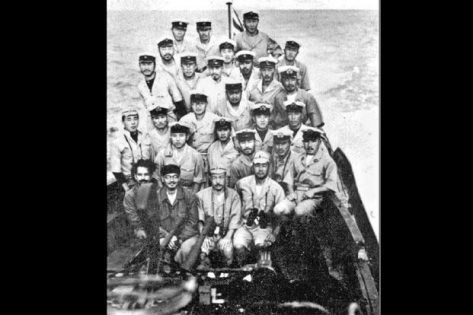
The crew aboard Japanese sub I-29 pose with their guest Bose (first row, second from left) and Hasan (to Bose’s right). Photographs courtesy ‘The Men From Imphal’/Netaji Research Bureau; Source: livemint.com
The crew had no idea about their mission and were mystified as it had been detained since long. All they knew were a special assignment was on the cards. They saw the five strangers board and then saw three of them leaving. Subhas with Hassan was set to pursue his dream, a single minded one at that. A dream to free his motherland. This was the first ever-human transportation of that kind where an important political leader has been offered a submarine passage to another distant territory. The crew had little idea that they would be a part of history of ever increasing magnitude and encompassing geographies never attempted before.
Subhas and Hassan were referred as two civil engineers being taken on board to be dropped at Norway to help in the constructions of Bunkers. Curiosity however got the better of the crew and one trainee Kahnert Willi sauntered past and saw from the corner of his eyes, two man in dark overcoats seated side by side, their hats beside them. They looked like a couple set for a funeral service.
A little later Subhas Bose and Abid Hassan had changed into grey trousers and green overhauls. They were now a part of the crew. They were sixty one now.
By then the crew members were told on the intercom that “the Indian Adolf” was on board. A section then got together and posed for a photograph with the leader of the Indian Freedom Movement.
Two days later, the U–Boat dropped anchor at Egersund just on the outskirts of Germany. The Commandar Musenberg emphasized the special duty, they were required to perform. It was decided that the submarine would not attack any ship on the way unless provoked to extremes. The members were asked to behave with all politeness and respect to Bose’s and Hassan’s religious affinities. That says a lot on the respect the Indian leader commanded.
The cramped living space was a new experience and if reports are to be believed, Bose did start to lose weight. The submarine was filled with smell of Diesel. Only beef or ham was available and that too didn’t want to be left behind of the smell. Bread, lintels and some rice was all he could manage for the first few days. In front of his mission however, they appeared trivial. Further as they crossed Bay of Biscay, the weather deteriorated and the submarine travelling 180 metres below the North Atlantic waters, was tossed about. Netaji and his companion suffered from terrible sea sickness but notwithstanding these challenges, Bose utilized the time in dictating and completing revisions of a new edition of Indian Struggle, preparing for speeches he would later deliver and yes he would also take interest in the operations of the U-Boat and the technicalities of aiming and firing the torpedo. He would visit each section where each of his curiosities would be answered gleefully.
Netaji also witnessed the marriage of a crew member but the bride was in Germany!!! Such events are normal in wartimes and marriages would take place over the radio. The cramped situations had improved by then. He took a keen interest in the kitchen and records show that he even handed out recipes of pulao and Indian curry, the spices for which was supplied by Netaji himself from his ample luggage. (My version is a crew member version).
During the passage, the submarine refueled from a U-tanker off Spain, torpedoed a British merchant ship SS Corbis off West African coast. That was the 18th of April and a couple of days later almost escaped being rammed by a cargo vessel. Netaji remained unnerved and composed, as per version of the trainee crew member.
The U-180 dodged allied ships along the vast stretch of the North Atlantic infested by British destroyers. The Allied were the first to introduce radars and this made it even more dangerous. The Germans lost many submarines as a result. Not this one though.
“We had a close shave once after surfacing and suddenly encountering a British Destroyer. Abid Hassan was shivering in that uncanny atmosphere of 180 metres below the Atlantic. Netaji sat composed.”
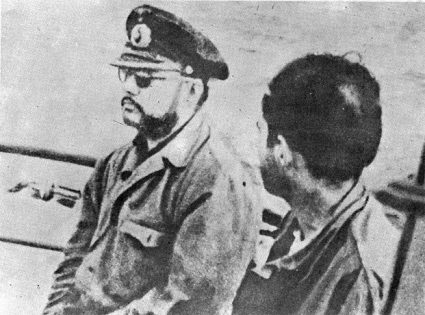
Source: livemint.com
Mid Sea Submarine Transfer
The Japanese Submarine I29 commanded by Mesao Teraoka arrived at the Mozambique Channel on 26th April. It was near the neutral Portugese territory. The submarine had left Penang on 20th on an ostensibly routine mission. The locals, many of them Indians, however could sense that intention of Commander Teraoka was anything but routine. “Why were the ship’s cook buying spices for Indian curry?”, they wondered. Rumours were already rife that the man of whom so much was heard could arrive any moment.
Fortunately, these gossips didn’t reach the ears of the British.
It was only at the destination that Teraoka made two revelations. The mission was to fetch Bose and second two Japanese would go to Germany back in the U-Boat and learn the technique of construction. In addition, two and a half tons of gold along with rice and quite a few cockroaches intended for the embassy.
The I29 had arrived some ten hours ahead of schedule and that too at dark. So both the sides decided on a pin drop silence, not even radio communication. Sunrise brought fresh problems. The sea became so rough that the two boats could only circle each other from a distance and hope for the weather to even out. In the meantime fuel was running out.
This prompted a daredevilry act from two German officials as the Japanese saw them jump overboard and swim towards them. They had to do the impossible tomorrow. It was now or never.
As the day dawned on the 28th April with the roughness of the sea still refusing to bow, the two Germans on a rubber raft dragged a strong Manila hemp rope back to their boat.
The river raft, the rope, Hassan and Bose. They found themselves literally hauled into the I29. A homecoming of sorts. The captain Juichi Izu organized a party the next day. Coincidentally that was the emperor’s birthday too.
As the I29 passed through the south of India on its way to the South East Asia, outside British Patrolling radius, tears ran down his eyes. A resolve to force his way through, triumphantly and leading….very soon.
The submarine in the meantime picked up a radio message from Penand instructing a detour to Sabang. Col Yamamoto, his old friend during his German days was present on the pier to greet him.
Netaji was finally on Asian soil. The resolve was growing stronger by the minute and the route to the “Mother” was not far off.
The three Ss: Secret Service and the Submarine
Hikari Kikan was responsible for the relationship of the Japanese Government with the PGAH. It recruited Sri Lankans and other South Asians apart from Indians in Malaya and Singapore for spying missions. Prior to arrival of Bose, these missions were mostly unsuccessfull. Bose then took control over the intelligence operation based at Penang and Burma, appointing NG Swami in charge of an intelligence school known as the Azad School. Apart from the well known Pabitra Kumar Roy case, several intelligence operatives, some of them recorded in March 43 and Dec 43 shows formation of different teams under the stewardship of Bose, Hasan and Swami.
Bhagwan Lu, Harbans Lal , Kanwal Singh and Kartar Singh accompanied Swami on the blockade runner S.S. Osorno. Another four trained personal armed with weapons, money and sophisticated wireless equipment was readied six months later and then all the eight under the leadership of SN Chopra boarded an I26 at Penang on 4th Dec and landed at southeast of Karachi on 21st December, 1943. This operation was codenamed “Operation Yo”. The team then split itself and established successful radio contact with Bose (he was in Burma by then) from various parts of the country. After the successful insertion, the I26 accounted for another 10 revolutions of INA, west of Karachi, in March 1944. The group was a special service group codenamed “Operations Bahadur” who would operate behind enemy lines and win over the Indian troops through espionages. Here one would like to add that many such agents were eventually captured and tried for treason.
The final aspect of the submarine connection brings us to the officers cadets of the INA better known as Tokyo Cadets. The cadets journey from Malaya to Japan by passenger cum cargo ship Ural Maru was tragically cut short, torpedoed by an US submarine. Ural Maru was torpedoed and sunk on 27th Sept, 1944 in the South China Sea by the American Submarine USS Flasher (SS-249) approximately 150 nautical miles west of Luzon.
There is a fourth story. Largely unverified. The water’s tryst with the war chest and Netaji’s destination for the unknown. Some other day perhaps when we know a little more.
Featured image courtesy: The Better India, sify.com and livemint.com
Courtesy
1. Study of Netaji Related Souvenirs in Moirang
2. Prof Modhu of Moirang College
3. Inputs from Illustrated Weekly of India.

